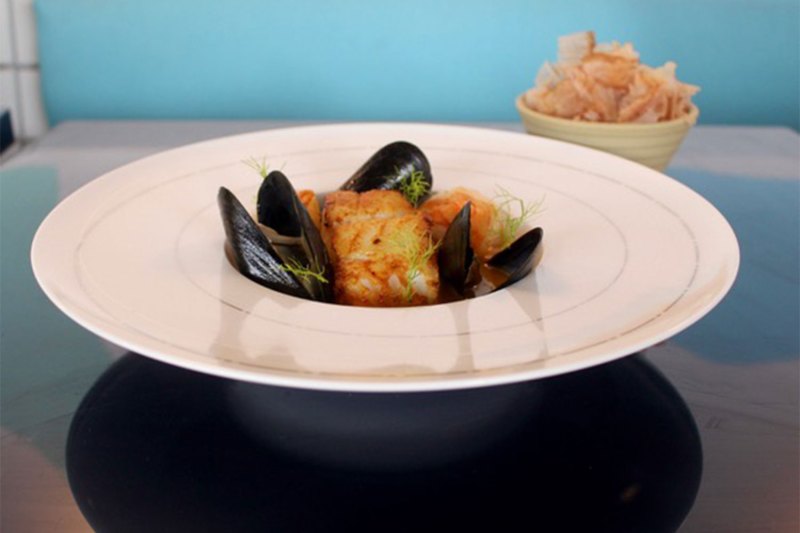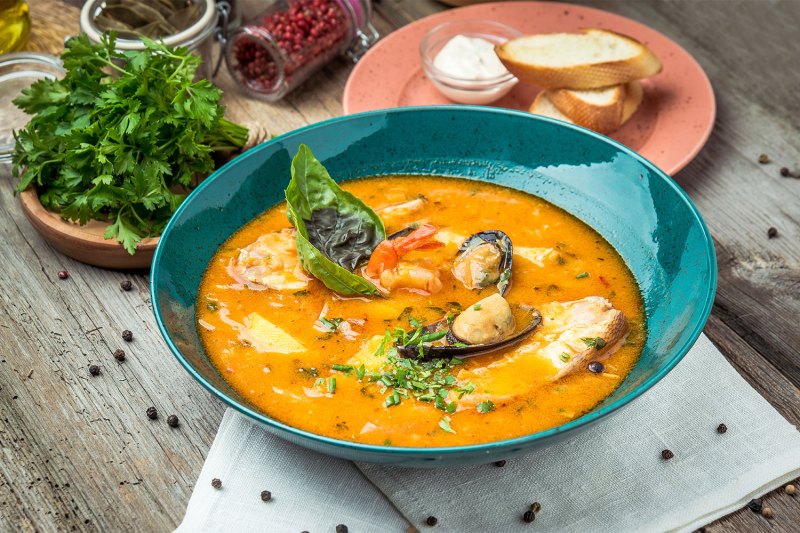Easily among the most recognizable and highly regarded dishes to come from the Provençal region of southern France is bouillabaisse, a rich seafood stew packed with fresh seafood and seasoned with bold aromatics like anise, fennel, and saffron. Bouillabaisse makes an appropriate feast for the summer season, since it originally hailed from the port city of Marseille, a Mediterranean town with gentle temperatures all year long. But as a hot, hearty dish with deeply developed flavor complexity, bouillabaisse can have a life far beyond the warmer months of the year. In fact, it’s an ideal transitional meal to easily guide you from summer to fall. If you’re ready to give this French staple a try, read on for some expert advice and a recipe to get you started.
Be sure to purchase fresh, high-quality seafood
Seafood serves as the most crucial element of a bouillabaisse; it’s not only the stew’s source of protein, but its flavor permeates every aspect of the dish, and all other ingredients exist to highlight and emphasize the seafood. For that reason, you’ll want to seek out the best fish and shellfish that you can find.
“Like many other European style fish stews such as cioppino and bacalao, bouillabaisse always tastes better with higher-quality ingredients, spices, and herbs. However, unlike a bacalao, which uses salt-preserved cod, bouillabaisse is still best with the freshest seafood possible,” head chef/owner/recipe developer Jessica Randhawa of The Forked Spoon offers by way of context.
Chef and cookbook author Amy Riolo agrees, adding that it’s completely fine to experiment with seafood ingredients, as long as they’re fresh. “Don’t worry about what seafood the recipe calls for; [just] use the freshest combination that you can get, the way that a fisherman would make this recipe with what they have on hand,” she insists.
A rich, flavorful fish stock should be your number one bouillabaisse priority
Fresh fish and shellfish make up the textural elements of a great bouillabaisse, but even the best versions of these items won’t save you if your broth lacks vibrant and well-balanced flavor. For that reason, chef/restaurateur Ken Irvine of Irvine Hospitality Group in San Diego, California urges you to remember that “the secret to good bouillabaisse is the base, the stock. Lobster shells are the best [for infusing the stock with flavor], white fish bones would be a good substitute, and shrimp shells are my least favorite. A combo of all three would be ideal. In a stock pot, brown the shells or bones in butter until the color pops; add garlic, shallots and make them sweat a bit. Add water and mirepoix (carrots, onions, celery), thyme stems and peppercorns. Simmer for about a half hour.”

Make sure to stagger your timing when adding the seafood to the broth
Slow-cooked stews like bouillabaisse sometimes feel like dangerous endeavors, because it can be deceptively easy to overcook the protein. In order to avoid this grievous fate, Frank Proto, the director of culinary operations for the Institute of Culinary Education, advises the following: “When you’re cooking a bouillabaisse, make sure to stagger when you add the seafood. You want to add the seafood that requires longer cooking earlier than any seafood that cooks quickly.”
Don’t skimp on pastis
Traditional bouillabaisse recipes include a healthy glug of pastis, a French apéritif spirit with a distinct anise flavor. Different versions of the dish will involve different quantities of pastis…but chef/owner Rob Shaner of Robert et Fils in Chicago, Illinois endorses a “more is more” approach. “I think the pastis pour [in a bouillabaisse] should be very heavy” is Shaner’s unambiguous recommendation.
If you can’t find saffron, swap in turmeric
The floral, slightly grassy flavor of saffron is a signature element of Provençal bouillabaisse, but its very high price and its scarcity at many U.S. grocery stores can make it a tough item to acquire. If you find yourself saffron-less while craving bouillabaisse, try this substitute suggested by Chef Chris Mentzer of Rastelli’s in Swedesboro, New Jersey: “Saffron is one of the main distinctions for this dish. It gives the broth that distinct yellow color and profound flavor like no other. However, if you’re on a budget or you can’t find it…a ½ teaspoon of turmeric does the same as a pinch of saffron!”

Top your bouillabaisse with rouille for an added boost of flavor
Like many other rich soups and stews, bouillabaisse can benefit from a nice kick of heat, and when it’s served in Provence, said heat usually comes in the form of a condiment known as rouille. “Rouille is the French word for ‘rust’, and [it’s also] the name of a spicy, hot, rust-colored paste made from red pepper, chili pepper, garlic, extra virgin olive oil, and breadcrumbs, which is stirred into the soup just before eating,” Amy Riolo explains.
Bouillabaisse
(By Nicholas Morales, executive chef, Bar Marseille, Averne, New York)
Chef Nicholas Morales’ Rockaway Beach restaurant focuses on Mediterranean-French cuisine, so he definitely knows a thing or two about bouillabaisse. He tells us that, when he makes the dish at home, he uses “katsuobushi, also known as bonito flakes, to add a beautiful smoky flavor to the dish. The bonito creates a nice depth of flavor and is a great trick when you don’t have a lot of time to build complexity in the soup. The combination of umami, anise, and seafood creates a surprisingly comforting dish ideal for home cooking in cool weather!”
Ingredients:
For Fish Stock:
- 1 large onion, minced
- 1 leek (whites only), minced
- 2 cloves garlic, crushed
- 0.5 head of fennel, minced
- 1.5 lbs fish heads or bones
- 3-4 ripe plum tomatoes
- Peel of 1 orange
- 1 celery stalk, cut in pieces
- 1 spring of thyme
- 1 bay leaf
- Pinch of cayenne (optional)
- 1 tsp pastis
- 1 cup bonito flakes
- 2 qts boiling water
For Bouillabaisse:
- 1-1.5 lbs white fish filets
- 0.5 lb (21-25) jumbo shrimp, peeled and deveined
- 1 lb mussels or clams
- 1 tbsp pastis
- 0.5 tsp saffron threads
- 0.25 cup olive oil
- 1 lb potatoes, peeled and cut into quarters in slices
- Salt, to taste
- Fresh ground black pepper, to taste
- Pastis, to taste
- Fish stock (full quantity)
- 1 baguette, cut into slices
Method:
- To make the fish stock, heat olive oil in a large heavy-bottomed stockpot over medium heat. Once the oil is hot, begin adding onions, leek, and fennel, stirring often to cook the vegetables gently. The vegetables should develop a light color and soften into the olive oil. If necessary, lower the heat.
- Once the vegetables soften, increase the heat and add any fish bones or heads you would like to use. At this point, you want to begin stirring aggressively. It’s fine for the fish to get bruised and/or fall apart.
- After 7-10 minutes of stirring the fish, add orange peel, thyme, cayenne, celery, bay leaves, pastis, and bonito flakes. Lower heat again to prevent burning and cook for 10 min, stirring constantly.
- Pour boiling water into the pot and lower heat to medium low. Let simmer for 25 minutes.
- Add the contents of the pot to a food mill, blender, or food processor (or use an immersion blender) and lightly blend. After blending, pass the liquid through a fine mesh strainer and set aside.
- Cut fish filets into 4 oz pieces and place into a bowl with shrimp. Add pastis, a pinch of saffron, 1 teaspoon olive oil, salt, and black pepper. Very gently, taking care not to break the fish, toss the ingredients together. Cover the bowl in plastic wrap and let marinate for about 3 hours, if time is available.
- Pour fish stock into a large, heavy-bottomed stock pot and turn up heat to high, bringing stock up to a boil. Once boiling, add remaining crumbled saffron.
- Add potatoes to pot and cook potatoes for about 10 min. If using firm fish (like monkfish), add after cooking potatoes for 5 min; if using lighter fish, add after cooking for 10 minutes. Also, add mussels and shrimp.
- Taste broth and adjust seasoning as needed. Once potatoes are tender, you’ll be ready to plate.
- Rub the baguette slices with garlic and lightly toast.
- To serve, carefully take out all the seafood from broth using a spotted spoon and transfer to plates. With a spoon, start transferring potatoes and broth to each bowl. Place sliced baguette on the side of each bowl.



